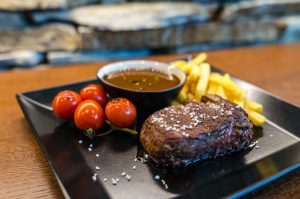Cooking with Himalayan pink salt – do you know what to do?
Cooking with Himalayan salt is no longer just for chefs in fancy high-end restaurants. More of us are now willing to experiment in the kitchen. Where we can experiment and add a dash of flair and flavor to our own home cooking.
With a wide range of salt products on the market it can be a bit confusing as to which salt you should use. Himalayan pink salt or Sea Salt? Or even Sea Salt or Table Salt? What is the difference anyway?
Himalayan pink salt isn’t just a pretty face (or grain!). While the rosy hue adds a delightful pop of color to your dishes, it can also enhance your food in other ways. This unique salt is said to have a subtler, slightly sweet flavor compared to table salt. This makes it a great choice for finishing dishes, where a delicate sprinkle can elevate the flavor profile without overpowering it.
For adventurous cooks, Himalayan pink salt offers a unique cooking experience. Salt blocks, carved from large chunks of the pink salt, can be heated to high temperatures. They then function as a natural cooking surface for searing meats, seafood, or vegetables. The salt adds a subtle salty flavor as your food cooks, and the presentation factor is undeniable! So, if you’re looking to impress your guests with a touch of culinary flair, consider trying a Himalayan salt block for your next dinner party.
Himalayan pink salt versus Sea Salt
Do you want to understand the difference between Himalayan pink salt and Sea Salt?
Are you unsure which salt you should choose? Also should you use pink Himalayan salt in cooking?
Let’s have a look and see if we can shed a bit of light on your dilemma regarding cooking with Himalayan salt..
What is the difference between Himalayan pink salt and Sea Salt?
What is Sea Salt?
Obtained through the process of evaporation of ocean water, or saltwater, from the seabed or large salt lakes, Sea Salt is a natural unrefined product. The white salt crystals that are left behind after evaporation are spread out and left to dry naturally.
Sea Salt undergoes minimal processing which helps it retain its large crystalline shape. Sea salt should not be mistaken for general table salt as table salt is mined from the ground and goes through several additional refinement steps. This includes the adding of anti-caking agents to the salt which help the flow of the table salt.
Sea Salt is a more natural product than table salt. Sea salt includes 72 trace minerals including iron, potassium, and zinc. The darker hues include more impurities than a bright white product.
What is Himalayan pink salt?
Pink Himalayan salt is mined by hand from the Khewra Salt mine in Pakistan, near the foot of the Himalayan Mountains. It is believed the salt beds were formed over 250 million years ago during the Jurassic era when the Indian tectonic plate and the Eurasian plate collided.
Unlike Sea Salt, Himalayan pink salt does not undergo a refinement process and retains its mixture of natural trace minerals. There are approximately 84 trace minerals in Himalayan pink salt which include calcium, iodine iron, potassium, magnesium, and zinc. The human body can easily absorb these minerals due to their small molecular size. So therefore it is believed that Himalayan pink salt may be a healthier alternative to Sea Salt.
Can Himalayan pink salt be used in cooking?
Use Himalayan pink salt in the same way you would use Sea Salt, with one small caveat. As Himalayan pink salt has a higher mineral content than your sea salt or regular salt remember that using it will affect the overall taste of your dish.
Chefs around the world enjoy using Himalayan pink salt, especially as a garnish, as it is particularly attractive due to the pink-colored grains of salt compared to the fine white grains of Sea Salt. Furthermore it is also suitable for use in cooking, baking or as an additional seasoning.
Is pink Himalayan salt good for steak?
Absolutely! Used as a seasoning for most meats Himalayan pink salt will help steak retain its flavor as the salt will absorb the juices during the cooking process.
As the Himalayan pink salt has a slightly larger crystalline structure than Sea Salt or table salt it can bring an added crunchy texture to your steak.
Pink salt cooking products
There are many reasons to use pink salt when cooking, but have you tried cooking on a Himalayan salt plate? Cooking on Himalayan salt blocks can add natural flavors during the cooking process. When slowly heated the salt block starts to release some of the 84 natural trace minerals that it contains. The salt blocks are suitable for use on stove-tops, grills and BBQs making them extremely versatile.
If you have never tried cooking with Himalayan salt, now is the time to try. With so many products on the markets, from gourmet salt sets to stylish pink salt blocks, there should be something there for you to choose.
Summary
There are many recipes available that use Himalayan pink salt as one of their ingredients. Why not pop on over to the Salt Recipe section to find out more.
More ideas
Or if you would like to buy some Himalayan pink salt why not have a look at our Salt Products section.
